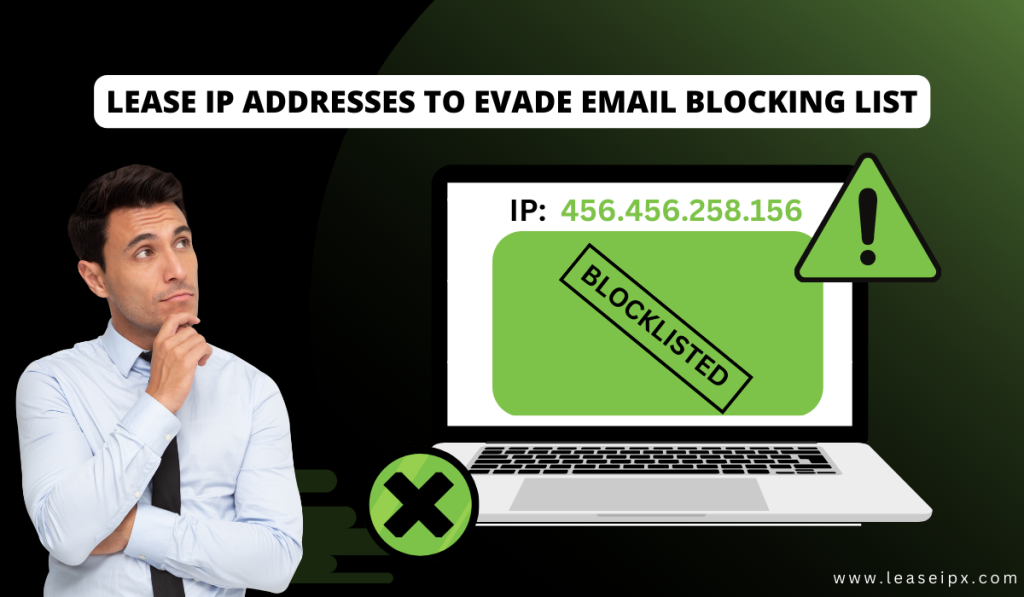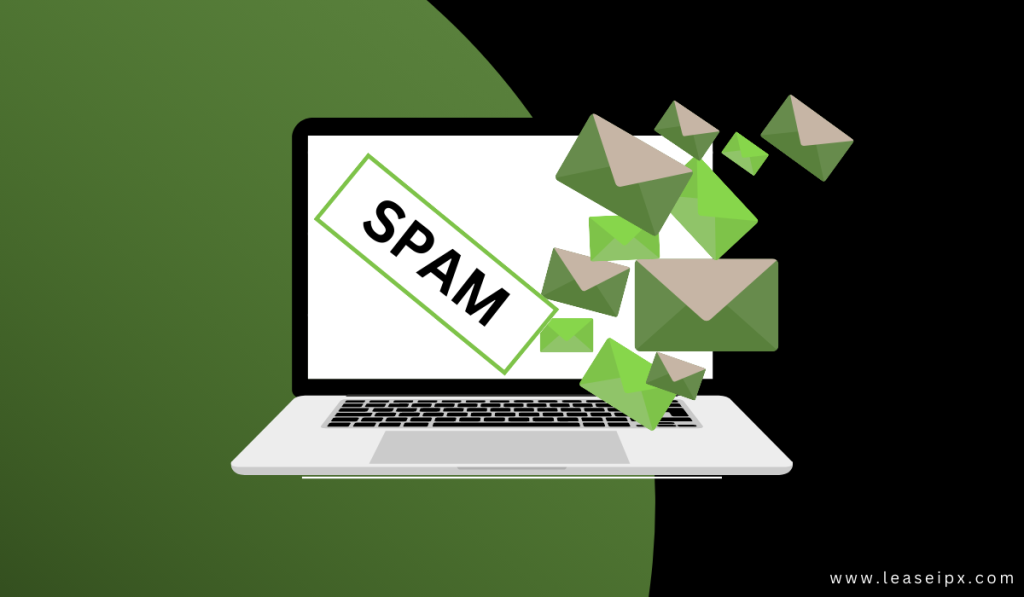The biggest reason why top email marketers prefer to lease IP addresses for creating successful campaigns is because many emails are lost in transit and never reach their intended recipient. This can be caused by multiple reasons. In some cases, the recipient’s inbox may be full, or the email address may have been misspelt, both of which might prevent emails from being received. Sad as it may be, there are further negative possibilities. It’s possible, for instance, that an email-blocking list now includes your domain name or IP address as a subscriber. For this reason, it is critical to understand what constitutes excellent IP reputation maintenance.
Read on to find out what a email blocking list is, its types, reasons for IP blocklisting and how the option to lease IP addresses can help you evade a blocklist.

What is an Email Blocking List?
Email blocking list are real-time databases that filter out spam and safeguard consumers from hazardous email content. It can also be called Blacklist or denylist or disallow list. Lets just call it blocklist for this blog.
The IP addresses, domains, and email addresses associated with spam are recorded in Email Blocking list:
- IP address: A device’s IP address is a numeric or alphanumeric designation used to identify it on the internet.
- Domain: Domains stand in for the actual names of the inboxes from which messages are sent.
- Email address: An email address is a unique label for a mailbox.
Email blacklists are compiled by email service providers (ESPs) and internet service providers (ISPs). Several ESPs and ISPs will begin blocking a server’s IP address or domain name if it is suspected of delivering spam or other dangerous content. Emails from the blacklisted IP or domain will be delivered to the Spam/Junk folder.
There are two kinds of email blocking list: those that are based on IP addresses, and those that are based on domain names.
IP Address-Based Blocklists
Depending on the actions of its owner, an IP address’s reliability might rise or fall. When an IP address is blacklisted, it loses some of its value and credibility.
What this means is that if your mail server’s IP address gets a bad reputation because of blocklisting, you are being treated the same as cybercriminals. In this way, even if you intended to send messages to the right people, they would never arrive in their inboxes.
This is the reason why it’s often said to buy or lease IP addresses after confirming that it has a good reputation.
Domain-Based Blocklists
All of your outgoing emails come from a certain domain. If the recipient is on a blacklist, the email will not be delivered. You can utilise reputable internet programmes that track spam sources (like MXToolBox or Spamhaus) to see if your mail server IP address or domain name is on their blacklist if you are concerned about your domain’s reputation.
As a whole, there are a few distinct categories of email blacklists:
- Identifying the origins of spam is made possible by enterprise firewalls.
- Internet service providers (ISPs) may also keep private or internal blocklists.
- Anyone can freely use public blocklists to see if an IP address or domain name is blocklisted.
Reasons IP Addresses get Blocklisted
The success of your email marketing and the reliability of your brand depend on your consistent adherence to best practices for email deliverability. But, you may be blacklisted if you consistently experience bounced emails to your return path (return address), send emails to users who have opted out of receiving them, or have an unexpected spike in spam complaints. The most common reasons for being placed on a blocklist are outlined below.
Spam
Every email provider out there works hard to ensure a problem-free experience for its customers. For an email marketer, though, bypassing spam filters is a must. Anti-spam software and filters check the message before it even enters the recipient’s inbox. Gmail, Yahoo, Outlook, and other email programmes, as well as ISPs like AT&T, Xfinity, or Verizon, all have these features built right in.
The filters look for warning signs including an abundance of graphics within the message, spam terms in the subject line, shortened URLs, an abundance of grammatical faults, and similar suspicious features. Both the sender and the recipient’s email addresses are significant.
Naturally, if several customers report an email from a certain IP address as spam, the service will probably add the address to a spam emails list and block it.

High Sending Volumes
An overabundance of email transmissions is a common rookie error. Because each blocklist has its own rules, it is impossible to provide a universally applicable answer to the question of how many emails can be sent before being blacklisted. But, your service provider may view a sudden increase from, say, 100 emails sent per week to 1,000 emails sent per day as spamming activity.
Mailbox providers may suspect that you have purchased an email list rather than organically grown one if you send a lot of emails out. Your email address may become unusable for sending messages of any kind as a result of this. Consequently, it is wise to gradually raise the number of emails sent, over a period of weeks or even months.
You could accidentally send a lot of emails. This could occur, for instance, if your database required an update or if you were the victim of a cyberattack. There is no way out of this predicament other than to cease all communication via email immediately. Then, get in touch with the spam list administrators and fix the blocklisting issue. Your name should be removed from the blocklist automatically once the problem has been fixed.
Targeting Invalid Emails
Reviewing your contact list from time to time and removing bounced email addresses is important. That is essential because unresponsive, inactive or temporary email addresses may be spam traps that decrease email open rates.
A spam trap is an inactive email address purposely left out in the open by an ISP. Spam traps usually fall into three groups.
- Pure spam traps: Spam-trap websites use fictitious addresses to lure infenders.
- Recycled spam traps: Email addresses and domain names that are still in use but have been repurposed as spam traps (for example, [email protected])
- Typo spam traps: Email addresses containing typos (for example, gmil.com instead of gmail.com, the true Gmail domain), implying that sent messages are never delivered.
Your sender’s reputation could be harmed if you don’t regularly check your data and wind up sending emails to addresses that no longer work or are invalid.
Improve your inbox clickthrough rates by adhering to best practices for managing your email list. Use methods such as the “double opt in,” where subscribers are prompted to confirm their subscription by clicking a link in a confirmation email, to grow your marketing email list. Always make it easy for users to unsubscribe from your email list.
You should keep all these points in mind when you buy or lease IP addresses to avoid your IP getting into the blocklists.
How to Work Around Blocklists
Maintaining a good sender reputation is easier when no actions are taken that can have the sender blacklisted. The more points you rack up in the game of building a good reputation, the closer you come to winning.
The success of email delivery relies on users adhering to the guidelines set forth by ISPs and email service providers. To that end, let’s try to clarify the situation.
Email Sender Reputation Upkeep
There are two components to your email reputation that are taken into account by email service provider algorithms: your domain’s reputation and your IP address’s reputation. An IP address or domain name that has just been created will initially have no history to speak about. The warning signs we’ve discussed so far should be kept in mind while you go about composing and sending emails in a methodical fashion.
Keep in mind that the identity of the sender can be inferred from the domain’s reputation. Keeping your domain’s reputation clean will prevent email providers like Gmail, Yahoo Mail, and Outlook from marking your messages as spam.
On the other hand, a computer’s IP reputation is more closely tied to the computer from which an email is sent. There are a number of variables that can affect one’s IP reputation. Whatever it is, whether it’s fresh, communal, or privately allotted, it’s yours.
When an IP address is not shared by hundreds of users, the likelihood of being blacklisted due to unsolicited email decreases dramatically. So, it is advisable to buy or lease IP addresses to acquire a permanent IP address.
Dedicated IP Address for every user
On a network, IP addresses can be shared. To save money and resources, ISPs and hosting firms join two or more websites under the same IP address. This is especially critical in the aftermath of IPv4 resource exhaustion.
If you opt to use a shared IP address, the reputation of other email senders is just as important as yours. As a result, malicious conduct by other users may result in blocklisting. As a result, the reputation of shared IPs is frequently compromised.
But when you have a dedicated IP address, only you are responsible for its reputation. So, by following the best practices you can maintain a good reputation for that IP address. The primary advantages of adopting a dedicated IP address are as follows:
- More safety because of the secluded setting
- Possessing total command over IP address standing and fortified blocklist security
- Increased command over the server’s settings
- Better functionality and user satisfaction because to quicker page loads
The need for dedicated IPs is a major factor in determining whether or not to purchase them. Yet if you’re an email marketer, the benefits are clear.
Lease IP Addresses for Email Marketing
There are no more available IPv4 addresses; they were all used up over a decade ago. Because of this, there are currently limited choices for how a business can acquire IPv4 addresses: Get on a list, pay for, or lease IP addresses.
The option to lease IP addresses, the allocation of IPv4 addresses in accordance with a lease agreement, might help your email marketing campaigns. Leasing companies that value their reputation will monitor blocklists and take good care of their digital assets. Before putting assets on the market, IP reputation issues are typically resolved.
For instance, LeaseIPx not only verifies the leased resources before the lease begins, but also monitors their IP reputation on a regular basis.
To get your hands on IP the quickest, look into the lease IP addresses option . You can sign a lease in a matter of days as opposed to weeks or months. If you elect to go the leasing route, you’ll have access to subnets from all five RIRs. A lease term that suits you best is also an option. Most importantly, you save a lot in capital expenditure when you lease IP addresses over purchasing them outright.
You now know that dedicated IPs, which can be accessed when you Lease IP addresses, can help reduce the likelihood of being blacklisted. Your responsibility for your dedicated IP address’s reputation grows as you do. If you adhere to accepted standards for sending email, your promotional messages will reach their inboxes and you won’t have to worry about being blacklisted.
Conclusion
In regards to email blocking list, there are two aspects to consider. On one hand, they are supposed to prevent spam from reaching regular email users. On the flip side, they aid in limiting the activities of email marketers.
If you want your emails to get through, you should follow the rules of responsible email marketing and watch your IP’s reputation. Never discount the value of the latter because it functions similarly to a digital signature.
Comparing the benefits of using a shared IP address to those of a dedicated IP address is straightforward. Only when all users of a shared IP address adhere to best practices when sending and receiving email will the shared IP address remain free of spam. A deviation by one group can have negative consequences for the whole. The sender’s reputation and the IP’s reliability are both under your control when using a dedicated IP.
LeaseIPx provides access to a dedicated IP address pool so you can take the reins of your email sender’s reputation. You can buy IP or lease IP addresses at lowest prices and easily evade Email blocking lists.
FAQs
How to lease IP addresses?
To lease IP addresses, simply visit LeaseIPx. You can find all about IP leasing by clicking here (Lease IP).
Should I buy IP or lease IP addresses?
It all depends on the amount of money you want to spend. If you have the budget to buy IP, you can buy it. If you’re tight on budget, you should consider the Option to Lease IP addresses. Find more about buy IP vs Lease IP addresses.
Which is the best place to Buy or Lease IP addresses?
There are many options to choose from when you decide to lease IP addresses. One of the best options is to visit LeaseIPx to lease IP addresses. Along with the option to lease IP addresses, they also have the option of buying and selling IP addresses. If you want to buy IP addresses, you can get it from LeaseIPx at best prices. If you have unused IPs, you can sell them at best possible prices.





